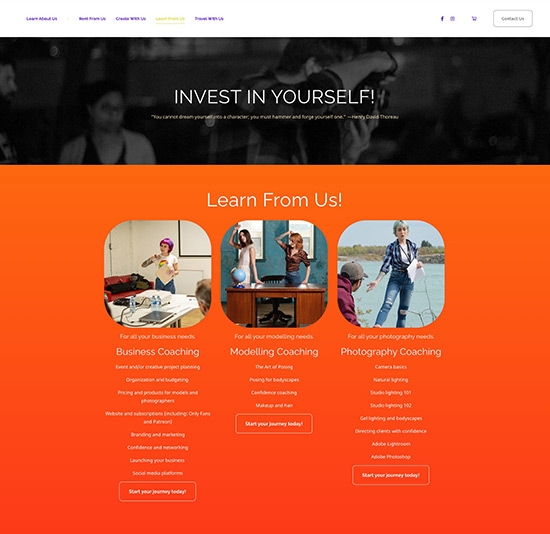Every professional is familiar with the importance of their resume. The resume introduces you to potential employers, and it quickly gives them an overview of your professional qualifications. But for creative and visual artists, the resume is missing one big thing--the visual element. If your craft involves creating things, the resume doesn't tell the whole story.
Portfolios are critical items for professionals from many fields. One industry that can benefit significantly from a great online portfolio website is marketing and advertising. Whether you're in the business of creating ads for other clients or you need to market your work, portfolios are an essential tool to master. Here is an list of easily customizable portfolio website templates for your use.
Why Do You Need a Great Marketing Portfolio?
Portfolios are usually associated with artists and photographers, but there are few professions where portfolios aren't helpful. They're the best way to sell yourself and your creations. Marketing professionals, in particular, can use a digital marketing portfolio template to showcase their best works. You can use it to land new clients or new jobs.
Perhaps the easiest way to sum up what a portfolio is and how you can best approach it is to say that a portfolio is your own advertising campaign. You're in the business of marketing other people's products, right? Now it's time to market yourself.
What Should You Include in Your Digital Marketing Portfolio?
Your marketing portfolio is a living document that grows with you throughout your career. It's important to keep adding to it, curating the content, and keep it growing. You may really love the projects you did when you first started out, but chances are you've gotten better. Your portfolio isn't really to show your journey and growth--it's mainly for showing potential customers what you can do for them.
It's good to focus on results on your website. Marketing is about more than flashy projects. How effective was the campaign? How much of it was under your control? Each project you choose to highlight should have some details so that the viewer can understand how hiring you will help their marketing endeavors.
People often wonder how many works should be highlighted in an online portfolio. In most cases, your mantra should be less is more. Five or six pieces of outstanding work are enough to make your point. If you load up your site with more than that, you'll likely lose your customer's attention.
Once the portfolio is up and running, curation is the most important task at hand. Whatever you do, you cannot allow your site to get stale. It will help if you showcase what you're doing for clients now, not years ago.
It helps to set up monthly calendar reminders to stay organized. Set time aside every month to clean house, remove old projects, and post new ones. If you take the time to sit down and look at the best things you've done over the last few weeks, you'll start a habit of keeping your portfolio fresh. Do read our article on 10 Tips to help you build an online portfolio that helps you stand out from the crowd.
How to Make a Marketing Portfolio Website - Step-by-Step Guide
There are a few elements to your portfolio that are non-negotiable. Most of these items are common sense, but it's worthwhile to give each section some thought. How can you make each one more impactful?
First Things First - The Layout
Before we dive into each section of your portfolio, you should take a few minutes to decide how you want the site to look and feel to your clients. There are few marketing theories that apply to web portfolios that will increase your success rate.
Firstly, you want your materials to be scannable. Most people scan websites before they start reading them, and studies show you only have eight to twelve seconds to grab a reader's attention. It's vital that you create a hierarchy on your webpage and highlight the significant bits. Use different text sizes, headings, and creative design to allow the viewer's eyes to settle on the important bits.
You also need to make your site easily navigable. The importance of this cannot be underestimated--how aggravating is it when you're on a great site, but you can't find what you're looking for? You want your best works to be easy to find and impactful. And then you want it to be super easy for clients to get in touch with you.
The layout and the site's design should come together with your portfolio of works to leave a lasting impression. Interactivity is a great way to make your site memorable. That means users have to click, scroll, and manipulate your page to expand on the interesting bits. Web design trends change with time, and the new layouts and themes are as dynamic and captivating as ever. Here are the top 10 Website Design Trends for 2021, to help you build your portfolio website.
Cover or Home Page
The cover or home page is where this all comes together. In essence, it's here that the client finds a table of contents, and it's here that all navigation is centered. It is about writing useful content that ‘speaks to your intended audience. Here are a few great tips on How to Write Great Content for Your Portfolio Website.
Check out the writer Portfolio Website Examples . Learn what makes them great and how you can improve your own portfolio.
Branding is an important goal of your home page. Have your name or business name front and center, and create an engaging personal headline that sums up who you are and what you do. Some in business might call this your mission or value statement. Whatever you call it, it should concisely communicate what you're trying to do for your clients. That's right--don't assume that the headline is about you. It's about what you can do for your clients. They found your website looking for something--use your headline to assure them that they're in the right place. Be sure to run your possible headlines past your friends and colleagues to see what they take away from it. Make sure that the message they receive from it is the message you intended to send!
Like all successful marketing campaigns, try to keep the look and feel of your website's branding consistent. You want a cohesive look. Choose a color palette and stick with it. Your work may provide a starting point. Ask yourself, what will show these products in the best light?
About Page
It's hard to decide what part of a portfolio website is the most important. The home page has to make an impression and convince your clients that you're worth their time to dig deeper.
But once they're hooked, it's all about the about page. You must make it easy to get in touch with you. In addition to your standard contact information, the website should have a quick and easy contact form. It should be linked to from multiple places on the site, and it should never take more than a second or two to find.
Another important aspect of your site should be social media integration. We had put together a Complete Guide to SEO for Photographers and Creators. So get started with delivering a great website experience by applying these principles to your portfolio website. Whatever sites you use most, be sure to link them. LinkedIn is a robust social network for professionals, and you should use it to connect your portfolio and share updates with your followers. If you share your creative works on a site like Instagram, Facebook, or Behance, link those too. But don't include social media platforms you don't use regularly--it's better to leave them out than to take your clients to a dead end.
Of course, the about page is more inclusive than a simple contact form. It's here that you can post a little more narrative about yourself. Include a short biography and your resume. List employers or big projects you've worked on. Don't forget to include awards and recognition you've received, as well as any professional affiliations or qualifications. If you are interested, here is the whole guide for step-by-step comprehensive guide to create a standout resume online.
Samples of Your Best Work
Finally, we get to the meat and potatoes of the marketer's portfolio--the portfolio part. As previously mentioned, don't go overboard by showing all of your big projects. The name of the game is curation--only show the best work that will really wow potential clients. Five or six works are plenty, but each project will have multiple elements.
Remember your audience. Show them why your campaign was so successful by getting them hooked, too. But the best parts of each campaign front and center. Include links or screenshots--as much as you can easily show. Depending on how you've laid out the page, make sure the thumbnail is the catchiest bit if you need people to click for more information.
So, how do you choose which projects to highlight in your portfolio? Here are a few things to think about.
- Always prioritize results. Which ads did you work on that produced quantifiable results for your client? How can you communicate this effectively to potential clients?
- Which of your works has been especially innovative or creative? What stood out from what your colleagues and competitors were doing at the time?
- Which projects were the biggest? Were there projects that had a lot of different elements, like print and digital integrations?
The portfolio section isn't just about showing an image and moving on. With a maximum of six projects highlighted, you'll want to provide some details. Allow your potential clients to take a deep dive into the project and explain the steps and creative process.
Spend time crafting a narrative that explains the customer and what you achieved for them. This all might seem like the boring part for you, but for future customers, it's a gold mine of information about what they can expect when they work with you.
Testimonials and Awards
Finally, highlight your past customers and personify them. Just a few words from happy clients adds an enormous amount of credibility to your site. Think about it, when you want to try a new restaurant, but it has no reviews, aren't you a little hesitant? Hiring a marketing professional is a lot riskier than one meal out.
Choose the Right Platform for a Digital Marketing Portfolio
The layout of the site requires quite a bit of consideration. It's a good idea to take a tour of other marketer's sites and see what works and what doesn't. In other words, do a little market research of your competition! The host site you choose should have lots of template options that should be powerful and impactful. They shouldn't distract from your work, though. They should make your work look good and keep it front and center.
Good website builders abound on the internet, but few are as targeted as Pixpa. Pixpa is explicitly created for portfolio websites, with well laid-out templates that showcase your work and put it in the best light. The best part of a service like Pixpa is that you retain complete control over your site. Templates are customizable, and there are never any annoying or distracting ads. It's easy to brand the site and make it your own.
Pixpa is an all-in-one platform for creators and small businesses to create beautiful, professional websites complete with a built-in online store, blog, and client galleries. Pixpa’s versatile platform has everything you need to showcase your work, share ideas and sell your stuff online, without any coding knowledge.
Building your website on Pixpa is super easy. Begin by signing up for a 15-day full-featured trial. Pick a template of your choice as the starting point. Pixpa offers a multitude of stunning, pixel-perfect, mobile-friendly templates. You can customize your site design using a simple & powerful visual style editor. Adding pages to your website is a breeze with Pixpa's drag-and-drop page builder. With a host of built-in tools such as SEO manager, Marketing Popups, Announcement Bar, and much more, you don't need any extra plugins to start growing your traffic and converting more leads.
Since its focus is clearly on creators, it's unsurprising that Pixpa templates and sites are gorgeous. Here are the best examples of portfolio websites built on Pixpa, for your inspiration. Their designs are clean and modern, and they offer many features that others don't only because of the types of sites people make here. The client galleries are the best example, where an artist’s clients can be provided a log-in to access their photos. Clients can then select, share, or save their favorite photos in proofing mode. With simple e-commerce integration, photos can be purchased directly from the website in print or download form. Pixpa goes one step further and can even create a custom mobile app for clients to download to their devices.
Create your professional portfolio website easily on Pixpa in minutes without any coding knowledge. Start your free trial now.
Here are some awe-inspiring marketing portfolio websites built with Pixpa that you must see.
Still wondering how to make a marketing portfolio website? Here are a few jaw-dropping and beautiful digital marketing portfolio examples created on Pixpa's platform for inspiration.
1. Media56

Looking for inspiration on keeping things clear and simple? Media 56 is an example of a targeted website. The message is driven home. Book a free ten-minute strategy call and get results. The landing page has no less than four "Book a Call" buttons, along with a scheduling widget. If you want to know more details, you can watch videos, making the site interactive. The only image is a screenshot of a happy client whose reach and impressions over social media shot up after contacting Media56.
2. Tegan McCann Photography

Tegan McCann is a working photographer in the UK, but part of their business focuses on creating ad campaigns for local pubs and restaurants. Combining excellent photography with catchy social media marketing, McCann creates eye-catching ads that are very specifically targeted. Coming from a photography background, McCann's site looks like a classic portfolio. But when you dig a little deeper, all of the essential details are there. It's easy for clients to get in touch, and the ad campaigns speak for themselves. An Instagram feed on the bottom of each page is a nice touch since it shows that McCann is active and provides an element that constantly updates the site.
3. McCall Media

McCall Media has a simple landing page that lays out exactly what they offer clients - photography, video, or digital marketing services. This is an important element in this day and age where many companies are offering various services. Get your clients pointed to the right area of your site early on. Likewise, the portfolio section of McCall's site is divided into specialized areas. For each section, there are links to a contact form and information about the services offered.
4. 101 Media House

101 Media House is a South Florida-based video production company that creates video ad campaigns for clients. From their landing page, visitors scroll to see their various products and services offered, and finally, a sample of projects you can get more information about. Being a video company, their products are embedded videos with lots of text descriptions. An extensive list shows the amount of work that went into making the product and exactly what 101 Media House's clients got for each project. The page ends, as it should, with a contact form.
5. Planning Addicts

Jenn Brockman at Planning Addicts specializes in planners and journals. Her site markets brandable content for your business offers up a free sample and includes happy customer reviews. It's a simple site that sticks to the basics and showcases her work. Clients who want to learn more about Brockman can surf through the other pages on her site to see various products she offers and affiliate options. The page ends with two important items that help Brockman keep the site fresh. There's a feed showing her latest blog posts, which encourage viewers to meet her through her writing. There's also an Instagram feed, a great way to get clients to connect with her and update the site.
6. Beyond Boundaries Academy

Beyond Boundaries has the headline, "Make an impression on the world," and is branded as the "creative hub of Winnipeg." The coaching service is specifically targeted at content creators like photographers, videographers, and businesses. Their home page is designed as a news and blog site, with each element cleverly showing what they do for their clients. They introduce themselves, offer client testimonials, and encourage engagement through their Instagram feed.
Conclusion
The portfolio you create is invariable going to be customized to your needs. Indeed, this is one of the most extraordinary powers of the portfolio website. They can take many shapes and forms, but they all share a single goal. They put your work in front of potential clients, and they showcase just what you want in the best way possible.
Do check out these articles
Frequently Asked Questions
1) What is a marketing portfolio?
A marketing portfolio is a portfolio for marketing professionals. Marketing professionals can also use a portfolio to showcase marketing campaigns, advertisements, case studies etc. that they have worked on and display their career growth. While portfolios are typically associated with artists, photographers and the like, marketers can also benefit from having a portfolio as a visual proof for their skills and experience.
2) What should go in a marketing portfolio?
Include a curated collection of your best work and project on your marketing portfolio. You can also add an ‘About’ page, a blog, testimonials from clients or employers and a contact form etc. Portfolios are all about marketing and promoting yourself, so make sure that everything you add to your portfolio adds value and helps you grow your career or reach in some way.
3) How do I create a marketing portfolio?
Once you have curated some of your best projects and created a plan for what you want your portfolio to look like, you need to create a website to host your portfolio online. But don’t worry because it's not as hard as it seems. In fact, you don’t need any advanced technical skills or coding knowledge. You can do it all yourself. Pixpa is an affordable and intuitive website building platform, especially designed for portfolio building. You can sign up now for a 15-day free trial. No credit card required.














